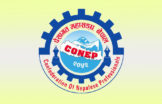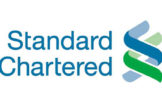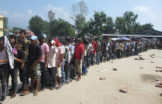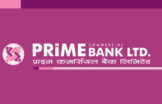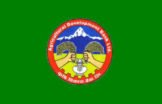Budget that could Destabilize Nepal’s Macroeconomy
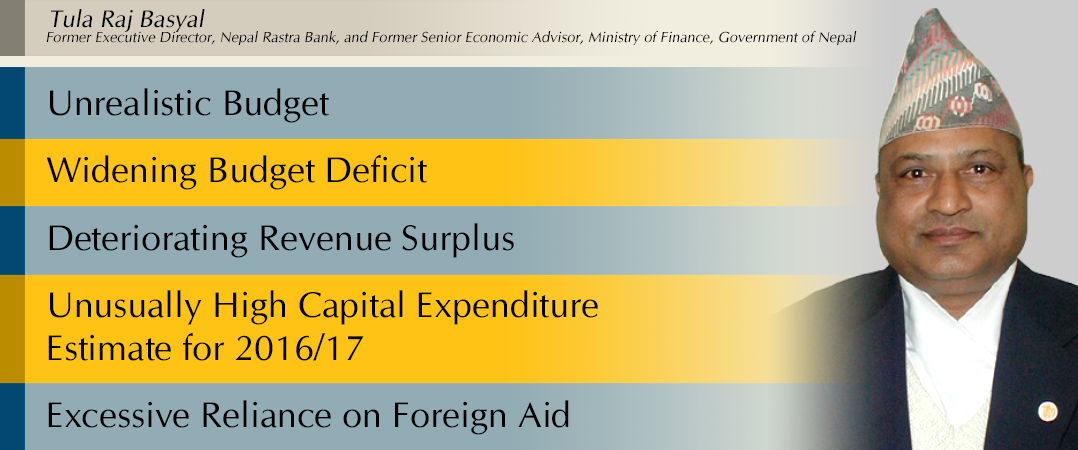
Tula Raj Basyal
Former Executive Director, Nepal Rastra Bank, and
Former Senior Economic Advisor, Ministry of Finance, Government of Nepal
Unrealistic Budget
The budget for fiscal year 2016/17 that was unveiled in the Parliament on May 28, 2016 is full of unrealistic assumptions and, therefore, is likely to destabilize the macroeconomy of Nepal. The Constitution of Nepal has mentioned achieving rapid economic growth and sustainable economic development coupled with ending economic inequality. At the same time, the Constitution states that the Government of Nepal shall assume the power to obtain foreign assistance and borrow loans, and such assistance or loans shall be so obtained or borrowed as to maintain macroeconomic stability of the country. However, the large deficit and other unrealistic aggregates of the budget for 2016/17 are destined to make the budget implementation process rough, risky, and uncertain. In such an environment, the various provisions made in the budget are difficult to be implemented and the objectives as mentioned in the budget shall be hard to achieve.
Widening Budget Deficit
There had been budget surplus in 2013/14 and 2014/15 whereas the revised estimate of the budget showed deficit in 2015/16. The budget deficit in 2016/17 is estimated to be substantially higher, viz., 10 percent of GDP (GDP at market price for 2016/17 projected at Rs. 2562.5 billion, on the basis of the targets of economic growth at 6.5 percent and inflation at 7.0 percent). It would not be advisable to maintain fiscal deficit/GDP ratio higher than 5 percent as the same could crowd out private sector investment. At a time when the investment level in the economy is already at a lower side, the effects of crowding out will not at all be favorable.
Deteriorating Revenue Surplus
Revenue surplus (revenue minus recurrent expenditure) as percent of capital expenditure is gradually declining, namely, from 97.7 in 2013/14 to minus 16.4 percent in 2016/17. As percent of GDP, it has fallen from 3.3 in 2013/14 to a budgeted minus 2.0 in 2016/17.
Unusually High Capital Expenditure Estimate for 2016/17
Of the total budget for 2016/17, the share of capital expenditure will be 33.6 percent (budgeted) compared to the share at 18.0 percent in 2013/14 (actual), 20.7 percent in 2014/15 (actual), and 26.8 percent in 2015/16 (revised estimate). As percent of GDP, capital expenditure will be 12.2 in 2016/17 from 3.4 in 2013/14, 4.2 in 2014/15, and 7.1 in 2015/16. The estimate for 2016/17 is unusually high while the revised estimate for 2015/16 also seems to be at a higher side.
Excessive Reliance on Foreign Aid
In 2016/17, foreign aid as percent of projected GDP is computed as 11.8 (debt inflows 7.6 and grants inflows 4.2) as compared to 3.0 percent (foreign debt inflows 1.2 and grants 1.8 percent).in 2014/15. So, the reliance on foreign aid in 2016/17 is projected to remain very high.
Excessive Reliance on Total Debt Inflows
As percent of GDP, foreign and domestic debt inflows in 2016/17 are projected to reach 11.97 compared to 1.94 in 2013/14, 3.20 in 2014/15, and 6.52 in 2015/16. Domestic debt inflows were greater than foreign debt inflows in 2013/14-2015/16 whereas foreign debt inflow is estimated to be higher than the domestic debt inflow in 2016/17. Similarly, total debt inflows as percent of total expenditure in 2016/17 are projected to reach 33.0 compared to 10.3 in 2013/14, 15.86 in 2014/15, and 24.7 in 2015/16. These indicate that the reliance on total debt inflows is on the rise over the years.
Conclusion
The budget for 2016/17 has placed increased reliance on debt sources as well as external aid. This is evidenced by the increase in revenue/GDP ratio by 1.60 percentage points compared to the increase in total expenditure/GDP ratio by 9.88 percentage points between 2015/16 (revised estimate) and 2016/17 (estimate). If we compare 2016/17 to 2014/15, the revenue/GDP ratio will increase by 2.66 percentage points compared to the increase in total expenditure/GDP ratio by 16.06 percentage points, signaling greater reliance on non-revenue sources. This tendency is not healthier and could land the economy of Nepal in further trouble. The projections by the budget for 2016/17 are haphazard, inconsistent, unscientific, irresponsible, and insincere. Inflation is bound to worsen and common people’s life will be further jeopardized. The budget will destabilize the macroeconomy and undermine the development efforts of the nation.
Table 1. Budget Aggregates (Amount in Rs. Billion and Ratios in Percent)
| 2013/14 Actual |
2014/15 Actual |
2015/16 Revised Est. |
2016/17 Estimate |
||
| Total Budget | 435.05 | 531.34 | 701.17 | 1048.92 | |
| As Percent of GDP | 22.15 | 25.06 | 31.18 | 40.93 | |
| Revenue | 368.66 | 411.85 | 460.43 | 565.9 | |
| F.Grants | 42.21 | 38.17 | 67.08 | 106.9 | |
| Rec Exp | 303.53 | 339.28 | 434.07 | 617.16 | |
| Cap Exp | 66.69 | 88.75 | 159.09 | 311.95 | |
| Total Ex | 370.22 | 428.03 | 593.16 | 929.11 | |
| GDP | 1964.54 | 2120.5 | 2248.69 | 2562.49 | |
| RE/TE | 81.99 | 79.27 | 73.18 | 66.42 | |
| Cap Exp | 18.01 | 20.73 | 26.82 | 33.58 | |
| Rev. Sur | 65.13 | 72.57 | 26.36 | -51.26 | |
| Rev. Sur/Cap Exp | 97.66 | 81.77 | 16.57 | -16.43 | |
| Budget Deficit | -40.64 | -21.99 | 65.65 | 256.31 | |
| For. Debt Inflows | 18.0 | 25.53 | 58.61 | 195.72 | |
| For. Aid | 60.21 | 63.70 | 125.69 | 302.62 | |
| For. Aid/TE | 16.26 | 14.88 | 21.19 | 32.57 | |
| For. Grants/TE | 11.40 | 8.92 | 11.31 | 11.51 | |
| F. Debt Inflows/TE | 4.86 | 5.96 | 9.88 | 21.07 | |
| Dom. Debt Inflows | 19.98 | 42.37 | 88.00 | 111.00 | |
| Dom. Debt Inflows/TE | 5.40 | 9.90 | 14.84 | 11.95 | |
| Dom. Debt Inflows/GDP | 1.02 | 2.00 | 3.91 | 4.33 | |
| Total Debt Inflows/TE | 10.26 | 15.86 | 24.72 | 33.02 | |
| Revenue/GDP | 18.77 | 19.42 | 20.48 | 22.08 | |
| F. Grants/GDP | 2.15 | 1.80 | 2.98 | 4.17 | |
| Recurrent Exp/GDP | 15.45 | 16.00 | 19.30 | 24.08 | |
| Capital Exp/GDP | 3.39 | 4.19 | 7.07 | 12.17 | |
| Total Expenditure/GDP | 18.84 | 20.19 | 26.37 | 36.25 | |
| Rev Sur/GDP | 3.32 | 3.42 | 1.17 | -2.00 | |
| Bud Def/GDP | -2.07 | -1.04 | 2.92 | 10.00 | |
| For. Debt Inflows/GDP | 0.92 | 1.20 | 2.61 | 7.64 | |
| Total Debt Inflows/GDP | 1.94 | 3.20 | 6.52 | 11.97 | |
| For Aid/GDP | 3.06 | 3.00 | 5.59 | 11.81 | |
| Cash Bal, Sur (+)/Def (-) | -14.36 | 11.34 | 18.06 | 59.41 | |
| Cash Bal/GDP | -0.73 | 0.53 | 0.80 | 2.32 | |
| Cash Balance/TE | -3.88 | 2.65 | 3.04 | 6.39 | |
Source: Budgets for 2016/17 and other previous budgets, Government of Nepal, MOF
Note: The opinions expressed in this article are the author’s own and do not reflect the view of the Bankko Samachar Pvt. Ltd.



